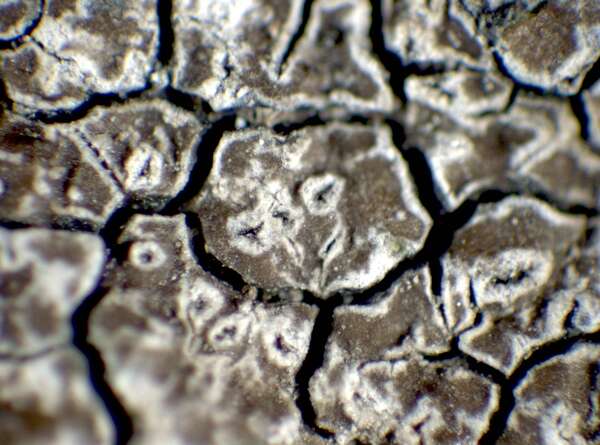Immersaria usbekica (Hertel) M. Barbero, Nav.-Ros & Cl. Roux
Bull. Soc. linn. Provence, 41: 140, 1990. Basionym: Lecidea usbekica Hertel - Khumbu Himal, 6: 1977.
Synonyms: Amygdalaria tellensis Esnault & Cl. Roux
Distribution: C - Laz (Tretiach 2004). S - Bas (Nimis & Tretiach 1999).
Description: Thallus crustose, episubstratic, areolate, pale brown to olive-brown, (0.8-)l-2(-4) mm thick, forming up to 30 cm wide, well-delimited patches. Areoles 0.3-2 mm wide, angular, sometimes faintly white-pruinose, with slightly raised, whitish margins, the peripheral ones sometimes elongate and radially arranged. Epinecral layer 5-15 µm thick, without crystals (except on the surface); cortex 20-25 µm thick, pale brown in upper part, colourless in lower part, rich in small crystals visible under polarized light; algal layer 50-100(-130) µm thick, more or less continuous; medulla white, up to 320 µm thick, rich in crystals, I+ blue. Apothecia lecideine, apparently aspicilioid, immersed in the areoles, 1-2(-3) per areole, more or less angular, often confluent, 0.3-1.5 mm across, with a slightly concave to flat, black but finely bluish grey-pruinose disc, and a thin, black proper margin. Proper exciple thin, pale grey-brown to dark green in outer part, colourless to pale grey within, K-; epithecium grey-black with an olivaceous hue, without crystals; hymenium colourless, 100-120 µm high, I+ blue then reddish brown; paraphyses branched and anastomosing, 1.7-2.6 µm thick at base, the apical cells slightly swollen, up to 4.8 µm wide; hypothecium colourless, not subtended by an algal layer. Asci 8-spored, narrowly cylindrical-clavate, with a I+ blue tholus and an internal, darker I+ tubular structure, the external gel I+ faintly blue, Porpidia-type. Ascospores 1-celled, hyaline ellipsoid, 13-24 x 7-14 µm , with a thin, non-amyloid epispore. Pycnidia dark, slightly immersed, projecting with a white-pruinose apical part. Conidia bacilliform, 6-16 x 0.9-2.5 µm. Photobiont chlorococcoid. Spot tests: cortex K-, C+ fleeting red, KC+ fleeting red, P-; medulla C-, KC-. Chemistry: cortex with gyrophoric, confluentic, and methylperlatolic acids.Note: on calcareous, or base-rich siliceous rocks in lowland areas, often growing on species of Aspicilia s.lat.
Growth form: Crustose
Substrata: rocks
Photobiont: green algae other than Trentepohlia
Reproductive strategy: mainly sexual
paras Aspicilia s.lat. spp. when young
Commonnes-rarity: (info)
Alpine belt: absent
Subalpine belt: absent
Oromediterranean belt: absent
Montane belt: absent
Submediterranean belt: absent
Padanian area: absent
Humid submediterranean belt: very rare
Humid mediterranean belt: very rare
Dry mediterranean belt: absent

Predictive model
Herbarium samples
Growth form: Crustose
Substrata: rocks
Photobiont: green algae other than Trentepohlia
Reproductive strategy: mainly sexual
paras Aspicilia s.lat. spp. when young
Commonnes-rarity: (info)
Alpine belt: absent
Subalpine belt: absent
Oromediterranean belt: absent
Montane belt: absent
Submediterranean belt: absent
Padanian area: absent
Humid submediterranean belt: very rare
Humid mediterranean belt: very rare
Dry mediterranean belt: absent

Predictive model
| Herbarium samples |
 INDEX FUNGORUM
INDEX FUNGORUM
 GBIF
GBIF





